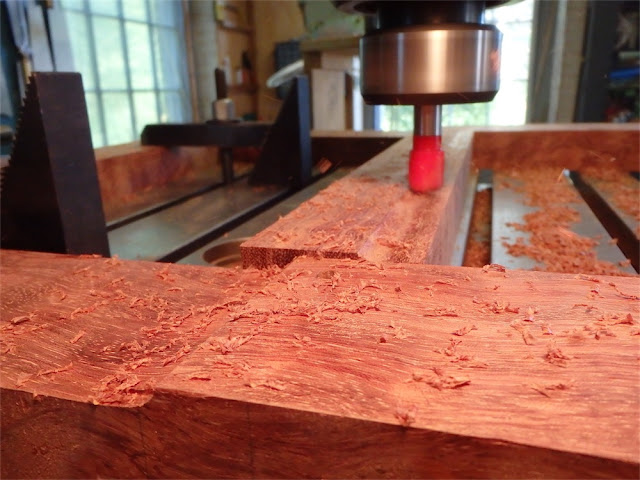Holy cow! 70 posts. How many months have passed? Ocean-going ships have been built and launched in the same time frame I’m sure, probably entire subdivisions of houses stapled together. Yes, this is a journal of a failed cabinetmaker, someone who took too long.
It’s hardly some sort of contest, but this is a long project, and I’d like to say I’m enjoying every minute of the process even if I sometimes think it is friggin’ endless. Sure, sometimes things go awry and I curse those capricious gods, but overall, it’s all about bringing something together which has been carefully thought out and planned, a matter of taking steps forward in determined fashion. And even with the planning, a certain portion is left to unfold organically. You can stare at a CAD drawing all day, but nothing informs like the object sitting in front of you. Still not totally certain how it will all come out and I’m fine with that. I hope you’re okay with that too.
The overall trajectory is satisfactory as far as I am concerned, and the client has been very supportive and patient too, which cannot be understated as being critical to what has unfolded. Nicest client I’ve ever had, hands down.
Working now on the bonnet, the top portion of the cabinet which gives some sense of visual termination to what would otherwise be a rectangular box on a splayed stand. Can’t have that, now can we?
The bonnet is formed from two bubinga framed assemblies, separated from one another by a shedua stand-off, also mortise and tenoned together, plus some bubinga stub posts, tsuka as they would be termed in Japanese. The lower bubinga frame was done in quartersawn bubinga, while the uppermost frame is done in curly bubinga, aka nightmare wood.
In this way of layering the parts, the pattern already set down at the stand is echoed in reverse, where a curly bubinga framework is surmounted by a quartersawn bubinga cornice. As with the stand, the structural logic of the ‘I’ beam is brought forth in the bonnet. With the stand the i-beam serves to provide a stiff support to the cabinet’s lower board so as to preclude any sagging in that board below all the drawers, while with the bonnet the function of the i-beam is to provide a stiffening element above the top of the carcase, which is a after all a board spanning atop the sliding doors. Making the bonnet framing stiff and anchoring it well to the upper carcase board should mitigate again the upper carcase board sagging downward over time due to gravity, which would cause the sliding action of the doors to bind slightly. Well, it is but a possibility of course, but wherever possible I want to design so that the structure’s aesthetics meshes as well as possible with loads as may be envisioned to manifest over the long term.
Template shaping comprises the first step in the process which I wish to share today- though in truth much cut out has already taken place on these parts:
Helical and carbide, plus an Aigner chip collection hood- what’s not to like?:
Four upper beams are shaped, and then they are ganged together for a bit of clean up:
The large diameter of the shaper cutter, of course, did not allow for the profile to be fully realized by that template shaping step, so additional work was necessary (on the pattern mill) to define the 'jog-ups’:
That was yesterday’s news, and the days’ previous, it might be noted.
Today I spent most of the shop time fabricating the cross members, and then with the joinery cut it was time to fit the parts together:
“Beat it to fit, paint it match”, as they say. Always looking for a bigger hammer and, optimally, a rusty pair of vice grips. How else do you get stuff done?
A closer look at the undersurfaces in union:
The first bonnet assembly is through the phase which could be called rough assembly:
I’ve left the cross members fat on top as they meet curved surfaces on the rails and cannot be readily processed to shape by themselves:
Those excesses are then relieved through more fixturing and milling work:
My dear friend, Fritz Zimmermann has proven to be stalwart. How’s that for a word you don’t hear every day?
Curly bubinga gettin’ a haircut:
Gradually, pass after pass after p…., the upper surface of the cross piece is brought into a match with the stepped and curved form of the rail:
The first cross piece is completed, at least as far as milling is concerned:
A while later, the second of the pair is milled:
While only two of the four cross pieces are shaped, impatient as I am, I couldn’t resist a look-see of the assembled parts atop the shedua standoff, to see how everything was fitting:
Amazingly, the parts seemed to be going together well. Another lucky day for me. The will be little stub posts to go in those corners, but, hey, one thing at a time.
All for this round. I’ll be back in the shop tomorrow and hope to move these bonnet parts along a bit further yet. Hope the tail end of your summer is coming in smoothly and with a clear-eyed view to the months ahead.
via Tumblr http://davidpires578.tumblr.com/post/149531317679
















No comments:
Post a Comment